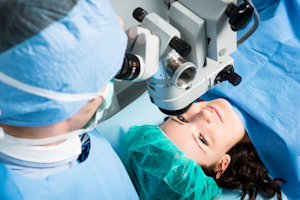LASIK versus PRK
At Elmquist Eye Group, we will evaluate the degree of your refractive error, the size of your pupils, and the thickness of your cornea to help you determine if LASIK versus PRK would be the best method of laser vision correction for your unique eyes.

Using state-of-the-art technology, Elmquist Eye Group provides a complete range of eye care services, including routine eye exams and diagnosis and treatment of cataracts; macular degeneration; diabetic eye disease; dry eyes; glaucoma; and other eye conditions.
Our surgeon, Dr. Yasaira Rodriguez, is a both board certified and fellowship-trained ophthalmologist who specializes in refractive surgery. She is committed to helping you regain the best possible vision.
What is “All Laser” LASIK?
At Elmquist Eye Group, we prefer the state-of-the-art all-laser LASIK procedure for the majority of patients. It involves two lasers: a femtosecond laser, which safely and painlessly creates a corneal flap with infrared laser energy instead of a metal blade, and an excimer laser, which reshapes the cornea to correct the refractive error.
All-laser LASIK offers several important advantages compared to the older LASIK technique which uses a metal blade:
- The risks associated with passing a metal blade through the surface of the eye are reduced.
- The flap is thinner and more precise, allowing for greater corneal stability and higher levels of correction.
- Both eyes can be treated in the same surgery session, one right after the other.
What is “PRK”?
Photorefractive keratectomy, also known as “PRK,” is a technique that reshapes the surface of the cornea without cutting a flap. The excimer laser removes epithelial cells from the surface of the cornea to alter its shape and allow light rays to focus more precisely on the retina.
PRK is often the safest, most effective option for individuals with thin corneal tissue, flat corneas, or corneal scars, who may not be good candidates for LASIK surgery.
If you undergo LASIK surgery, the corneal flap typically takes only a few days to heal, and your vision usually improves quickly. If you need to undergo PRK, the cornea to heal may take up to one week to heal, and it may be several weeks before your vision reaches its maximum sharpness.
Are LASIK and PRK Painful?
Most patients are surprised to find that LASIK and PRK are quick and painless. Your eyes are numbed with anesthetic eye drops, and there is no pain or discomfort.
Any minor irritation you may feel after LASIK surgery can be alleviated with artificial tears and sleep. PRK patients may experience a bit more discomfort after surgery, and the healing time may take a few days longer while new epithelial cells are being regenerated.
Trust the experts when it comes to your eyesight. The doctors at Elmquist Eye Group will discuss LASIK versus PRK and help you decide what is best for your eyes. Schedule an evaluation today by calling (239) 936-2020.
